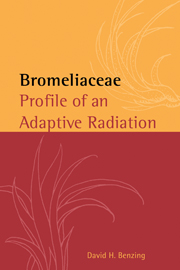Book contents
- Frontmatter
- Contents
- List of contributors
- Preface
- Acknowledgments
- Glossary
- Abbreviations
- Part one Brief overview
- Part two Basic structure, function, ecology and evolution
- Part three Special topics
- 10 Neoregelia subgenus Hylaeaicum
- 11 Cryptanthus
- 12 Tillandsioideae
- 13 Tillandsia and Racinaea
- 14 Ethnobotany of Bromeliaceae
- 15 Endangered Bromeliaceae
- Literature cited
- Name index
- Subject index
- Taxon index
14 - Ethnobotany of Bromeliaceae
from Part three - Special topics
Published online by Cambridge University Press: 19 January 2010
- Frontmatter
- Contents
- List of contributors
- Preface
- Acknowledgments
- Glossary
- Abbreviations
- Part one Brief overview
- Part two Basic structure, function, ecology and evolution
- Part three Special topics
- 10 Neoregelia subgenus Hylaeaicum
- 11 Cryptanthus
- 12 Tillandsioideae
- 13 Tillandsia and Racinaea
- 14 Ethnobotany of Bromeliaceae
- 15 Endangered Bromeliaceae
- Literature cited
- Name index
- Subject index
- Taxon index
Summary
Beyond its numerous, valuable ornamentals, Bromeliaceae contains relatively few widely used species, pineapple and Spanish moss being the two notable exceptions. Pineapple, Ananas comosus, ranks among the most popular of the tropical fruits (Cobley 1976). Spanish moss (Tillandsia usneoides) was once an important source of low-grade fiber in the southeastern United States, with annual production of up to 5000 tons. This wideranging species also has important medicinal uses in several regions, and an undocumented amount of material continues to sell for floral arrangements in the United States.
Hortus Third (L. H. Bailey Hortorium 1976) describes nearly 250 selections distributed among 30 genera. Hybrids, some between members of different genera, substantially augment the hundreds of species in cultivation. Although flowers tend to be small and ephemeral, unusual vegetative forms, ornamented leaves (e.g., Figs. 2.17B, 2.18B) and brightly pigmented floral bracts assure horticultural interest. Red, orange or yellow inflorescences of the many bird-pollinated bromeliads often signal from impressive distances. Sizes ranging from diminutive Spanish moss to giant Puya raimondii further entice hobbyists, and shade-tolerance suits many taxa for indoor cultivation. Frequent capacity to grow on a variety of substrates, including drift wood, cork slabs and fern roots, further enhances the popularity of bromeliads.
Bromeliaceae figure prominently in several additional contexts including cameo appearances in Star Trek movies and Star Trek: The Next Generation. Tillandsia usneoides and other epiphytic bromeliads adorn the sets of Tarzan movies, belying the films' purported African setting. Recent appearances include Medicine Man,where Sean Connery's character finally identifies Tillandsia punctulata, or rather the ants nesting within, as the source of a cancer cure.
- Type
- Chapter
- Information
- BromeliaceaeProfile of an Adaptive Radiation, pp. 587 - 608Publisher: Cambridge University PressPrint publication year: 2000
- 2
- Cited by



